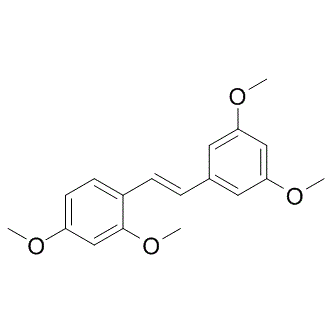| Description: |
TMS is a selective inhibitor of CYP1B1 activity. |
| Target: |
CYP1B1 |
| In Vivo: |
To determine the contribution of CYP1B1 in development of hypertension in spontaneously hypertensive rats (SHR), the effect of TMS is examined on in SHR and WKY rats. Systolic BP steadily increases in SHR from 4 weeks of age. Starting from 8 weeks of age, daily injections of TMS reduce systolic BP in SHR to levels observed at the beginning of the experiment (207±7 vs. 129±2 mmHg). Systolic BP is not altered in WKY injected with TMS or its vehicle (129±7 vs. 127±4 mmHg) [1]. |
| In Vitro: |
TMS, an analogue of resveratrol, is considered to be a potential cancer preventive agent since it is a potent inhibitor of CYP1B1. To assess survival of MCF-7 cells exposed to 1 μM benzo[a]pyrene (BP), 1 μM BP+1 μM TMS and 1 μM BP+4 μM TMS, cells ae incubated for up to 72 h without a media change. Luminescence units from exposed cells, expressed as a percentage of luminescence units from solvent (DMSO)-treated cells at the same time intervals. In all exposure groups, cell viability remains >90% for the first 24 h, but by 72 h, cell survival drops to 60-70%[1]. |
| Cell Assay: |
Cell viability is determined using the Cell Titer Glo Luminescent Cell Viability Assay. In brief, MCF-7 cells are seeded in 12-well plates (75 000 cells per well) in triplicate. Attached cells are exposed to 1 μM BP in the presence of 0, 1 or 4 μM TMS. At 4, 12, 24 or 72 h, RIPA Lysis Buffer (1x) is added to lyse the cells. A diluted sample of homogeneous cell lysate is transferred in duplicate to a 96-well plate and combined with an equivalent volume of Cell Titer Glo Luminescence. Luminescence measure using the Tropix 717 Microplate Luminometer. To examine viability of cells exposed to BP alone, the 72-h treatment is repeated twice, and for each experiment cells are assayed in triplicate. The values are expressed as % of the DMSO-alone solvent control[1]. |
| Animal Administration: |
Mice[1] 36 three-weeks-old male spontaneously hypertensive rats (SHR) and 36 age-matched WKY are used throughout this research. Each strain of rats is split into two groups; one group is injected daily with TMS (600 μg/kg) and the other with vehicle (DMSO; 100 μL) beginning at 8 weeks of age. Systolic BP and mean arterial pressure (MAP) are measured twice a week from 4 weeks of age; a noninvasive tail cuff method is used[1]. |
| References: |
[1]. Einem Lindeman T, et al. The resveratrol analogue, 2,3',4,5'-tetramethoxystilbene, does not inhibit CYP gene expression, enzyme activity and benzo[a]pyrene-DNA adduct formation in MCF-7 cells exposed to benzo[a]pyrene. Mutagenesis. 2011 Sep;26(5):629-35.
[2]. Jennings BL, et al. Cytochrome P450 1B1 contributes to increased blood pressure and cardiovascular and renal dysfunction in spontaneously hypertensive rats. Cardiovasc Drugs Ther. 2014 Apr;28(2):145-61. |






















